Morinji Temple 茂林寺
|
Title   • File Name • File Name   • Date • Date   • Position • Position   |
|

Morinji is a Soto-Zen temple famous for the Bunbuku Chagama (分福茶釜) folk tale about a tanuki raccoon dog that transformed into a steel pot used by the temple priest. Near Morinji-mae Station on the Tobu Line. One stop before Tatebayashi Station.
|
|

Morinji-mae Station. Morinji temple is a short walk away (660 meters).
|
|
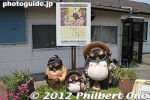
A symbol of Tatebayashi, Tanuki raccoon dogs welcome you in front of Morinji-mae Station. A hint of what's in store. A story panel starts to explain the tanuki story. Other story panels are found on the way to the temple.
|
|

The first panel explaining the famous Bunbuku Chagama (分福茶釜) folktale about a tanuki raccoon dog which turned into a tea pot. Morinji temple is where the folktale originated. There are multiple versions of the story.
|
|
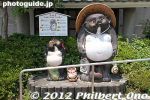
Even at the Morinji temple parking lot, tanuki statues.
|
|

Women's restroom at the Morinji parking lot has a tanuki design.
|
|
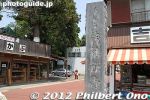
The way to Morinji temple is lined with some tourist souvenir shops.
|
|
|
|
|
|

First you see this Somon Gate (総門), built in 1468 and normally called Kuromon Gate (黒門), to enter Morinji temple, one of Tatebayashi's main tourist sights.
|
|

Map of Morinji temple. Morinji was founded by the priest Dairin Shotsu (大林正通), During a pilgrimage, Shotsu met an old priest Shukaku-osho at the foot of Ikaho in Gunma.
|
|

In 1426, Shotsu took Shukaku with him to Tatebayashi and built a tiny temple. In 1468, the local Aoyagi Castle lord Akai Masamitsu (赤井正光) indebted to Shotsu, donated some of his land for the temple.The 13th panel explaining the famous Bunbuku Chagama folktale.
|
|

The Sando path (参道) from Somon Gate to Sanmon Gate (山門) is lined with 21 tanuki statues on both sides. The temple really plays up on its Bunbuku Chagama folktale fame.
|
|
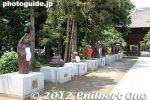
Tanuki statues on the left side of the Sando path to the Sanmon Gate.
|
|
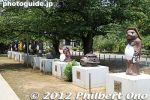
Tanuki statues on the right side of the Sando path to the Sanmon Gate.
|
|

A few statues shows a tanuki morphed into a steel tea pot at Morinji temple, Tatebayashi, Gunma Prefecture. Based on the Bunbuku Chagama folktale.
|
|
|
|

Another tanuki morphed into a steel tea pot at Morinji temple, Tatebayashi, Gunma Prefecture. Based on the Bunbuku Chagama folktale.
|
|
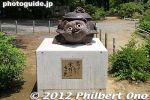
In folklore, tanuki is a mischievous shapeshifter so it is often depicted in many different costumes.
|
|
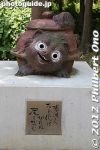
Tanuki morphed into a steel tea pot at Morinji temple, Tatebayashi, Gunma Prefecture.
|
|
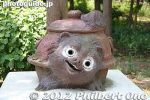
Tanuki morphed into a steel tea pot at Morinji temple, Tatebayashi, Gunma Prefecture.
|
|
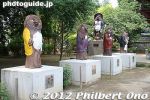
The statues recently got painted. Before, they were just bare stone statues.
|
|

Most of these tanuki came from Shigaraki in Shiga Prefecture. Shigaraki is one of Japan's most famous pottery centers.
|
|

Tanuki raccoon dog statue at Morinji temple at Tatebayashi, Gunma Prefecture.
|
|
|
|

Shigaraki tanuki is said to bear Eight Lucky Omens (八相縁起). 1. The hat is protection from unexpected disasters...Shigaraki tanuki is said to bear Eight Lucky Omens (八相縁起). 1. The hat is protection from unexpected disasters. 2. The smiling face is for affability, 3. The large eyes is for seeing the situation and making correct and considerate decisions, 4. The large belly is for being calm as well as bold, 5. A sake flask in the left hand for innate virtue, 6. An unpaid bill in the left hand symbolizes trust, 7. Large gonads between the legs which is the money bag for prosperity, and 8. A thick tail for reliability and stability no matter what.
|
|

2. The smiling face is for affability...
|
|
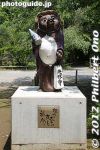
3. The large eyes is for seeing the situation and making correct and considerate decisions...
|
|
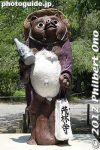
4. The large belly is for being calm as well as bold...
|
|
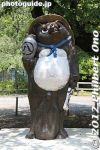
5. A sake flask in the left hand for innate virtue...
|
|
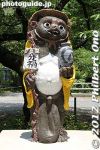
6. An unpaid bill in the left hand symbolizes trust...
|
|
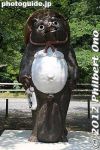
7. Large gonads between the legs which is the money bag for prosperity...
|
|
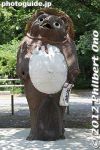
8. A thick tail for reliability and stability no matter what.
|
|

Tanuki raccoon dog statue at Morinji temple at Tatebayashi, Gunma Prefecture.
|
|
|
|
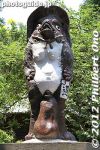
A giant Tanuki raccoon dog statue at Morinji temple at Tatebayashi, Gunma Prefecture. Donated by Tobu Railway in 1960.
|
|
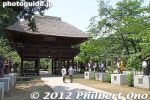
Sanmon Gate at Morinji temple. 山門
|
|
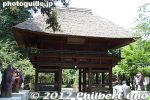
Sanmon Gate at Morinji temple. The Sanmon Gate is usually called the Akamon Gate 山門(通称赤門). The largest and most distinguished-looking gate.
|
|
|
|

A large weeping cherry tree hides the Hondo main hall.
|
|
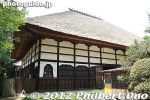
Morinji temple's Hondo main hall. 本堂
|
|
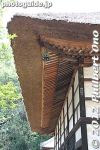
The Hondo Hall has a thatched-roof.
|
|

Morinji temple's Hondo main hall. 本堂
|
|
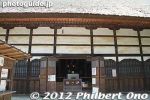
Morinji temple's Hondo main hall was originally built in 1468 and repaired in 1727. 本堂
|
|
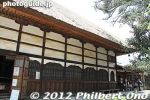
Morinji temple's Hondo main hall can be entered through the reception window on the right. 300 yen admission charged (150 yen for kids). Open 9 am-4 pm. Closed Thu.
|
|

Morinji temple's offertory box and altar inside.
|
|
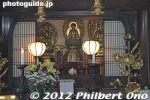
Morinji temple's Buddhist altar inside the Hondo Hall. The Shakanyorai (釈迦如来) or Gautama Buddha is worshipped. 本堂
|
|
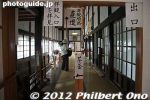
Pay a small admission fee to enter the Hondo from the right side. You can walk around inside the Hondo hall and see the altars.
|
|
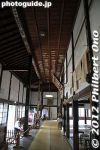
Inside Hondo hall.
|
|
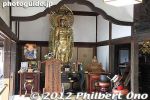
A side altar inside the Hondo hall.
|
|

Morinji's Hondo hall also has statues of the temple founder Chief Priest Dairin Shotsu-Osho (大林正通大和尚) and longtime assistant Priest Shukaku-Osho (守鶴和尚).
|
|

A palanquin exhibited near the ceiling.
|
|

Then there's a showroom of many tanuki sculptures, both wooden and stuffed.
|
|

Tanuki sculptures
|
|
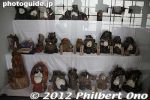
Tanuki statues in the showcase looked very old.
|
|
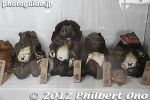
Old Tanuki statues at Morinji temple,
|
|
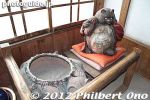
Tanuki hibachi
|
|
|
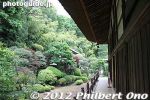
The rear of the Hondo hall has a nice green garden.
|
|

The rear of the Hondo hall has a nice green garden.
|
|
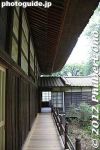
Walk along the veranda to another room exhibiting the legendary chagama tea pot.
|
|
|

Room exhibiting the legendary chagama tea pot in Morinj temple, Tatebayashi, Gunma.
|
|
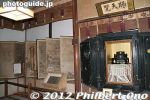
Room exhibiting the legendary chagama tea pot in Morinj temple, Tatebayashi, Gunma.
|
|
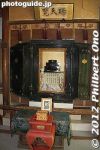
The legendary chagama tea pot in Morinj temple, Tatebayashi, Gunma.
|
|
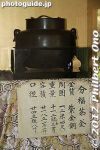
The legendary chagama tea pot in Morinj temple, Tatebayashi, Gunma.
|
|

About the the legendary chagama tea pot in Morinj temple, Tatebayashi, Gunma. There are other versions of the folktale.
|
|
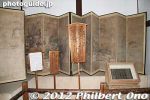
Folding screen showing the temple's connection to the Bunbuku Chagama folktale.
|
|

Temple's connection to the Bunbuku Chagama folktale.
|
|

A room with more scrolls and paintings of chagama.
|
|

Painting of a tanuki chagama.
|
|
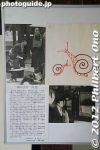
Article showing artist Yamashita Kiyoshi visiting the temple.
|
|
|
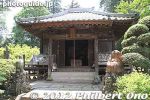
Shukaku-do Hall dedicated to the priest Shukaku-osho (守鶴和尚), a longtime priest supporter of Morinji temple and who brought the legendary chagama pot. 守鶴堂
|
|

Inside Shukaku-do Hall.
|
|
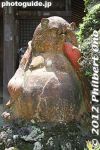
Tanuki statues at Shukaku-do.
|
|
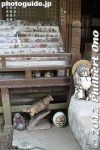
Tanuki statues at Shukaku-do.
|
|
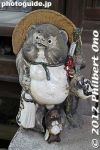
Tanuki statues at Shukaku-do.
|
|
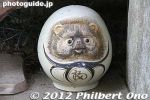
Daruma with a tanuki face.
|
|
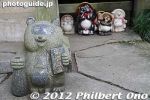
Tanuki statues at Shukaku-do.
|
|

Tanuki statues at Shukaku-do.
|
|

Tanuki statues at Shukaku-do.
|
|

Tanuki statues at Shukaku-do. This one was says "Welcome" in Kansai dialect, saying ""oideyasu."
|
|

War memorial for the Imperial Japanese Army's 2nd Tank Division which was annihilated at the Battle of the Philippines during World War II. 戦車第2師団工兵隊の碑
|
|

Cemetery next to the Hondo Hall.
|
|
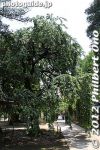
Large weeping cherry tree in front of the Hondo.
|
|
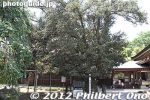
Yew plum pine
|
|
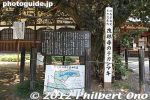
Yew plum pine
|
|

About the Yew plum pine.
|
|
|
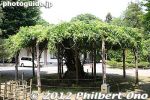
Wisteria tree
|
|
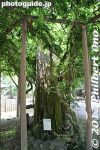
Wisteria tree
|
|
|
|
|
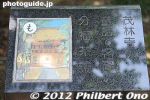
A stone marker for Morinji temple, designating it as one of Tatebayashi's 100 Famous Sites.
|
|
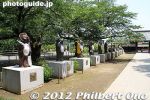
On the way back out, passing by the 21 tanuki raccoon dog statues again.
|
|
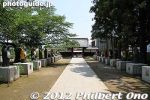
Disturbing news: On Dec. 19, 2022, two tanuki statues on a nearby bridge were destroyed by vandals. Then on Jan. 10, 2023, a roadside tanuki statue was knocked over and broken. All three were city property and not part of the temple.
|
|
|
|
|